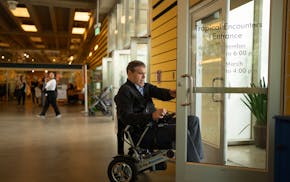The train rumbling through Raymond, Minn., in the early morning hours of March 30 worsened an existing rail surface condition, causing a section of track to break underneath the train, according to a report released Monday by the National Transportation Safety Board.
The fiery derailment forced the evacuation of about 800 people from their homes in the southwest Minnesota town and caused an estimated $1.9 million of damage to railroad equipment and tracks.
A preliminary report released in April said a fractured rail was found after the incident but stopped short of stating the broken rail caused the derailment. The new report lists the cause as the "catastrophic" rail failure at the Raymond elevator track switch. "Post-accident inspections and evidence obtained indicate the track-train dynamics worsened a rail head surface condition until a complete sectional break out of the rail head occurred underneath" the train, the report said.
About two dozen train cars jumped the tracks, some landing on their sides and some in an "accordion fashion," the report states. Hazardous materials leaked from five tank cars: Two of the cars sustained punctured shells and released ethanol, which ignited and destroyed gaskets on three additional tank cars and led to the further release of hazardous materials and spreading fire, the report said. The environmental cleanup was estimated at about $1.6 million, documents state.
Similar deficiencies with tank car gaskets were identified after a 2022 derailment in Texas, and the NTSB recently released new standards for gaskets, as well as new specifications for tank cars carrying hazardous materials to ensure appropriate thermal protections are in place.
The report says the train was traveling about 45 mph, under the 49 mph speed limit, and none of the employees involved had drugs or alcohol in their system.
Documents released Monday include information about pre-trip inspections of the rail cars, which were loaded and inspected in Marshall on March 24, but documents do not state when the last inspection of the track was completed.
A BNSF spokesperson on Monday didn't disclose when the track through Raymond was last inspected but said the company "regularly conducts extensive track, bridge, rail and weather event inspections across our network" using a combination of rail cars and trucks, bridge inspection vehicles, unmanned aerial vehicles and specially trained inspectors.
"We meet or exceed all federal inspection requirements," the spokesperson said via email.
After the derailment sent plumes of fire and smoke into the night sky — and as temperatures hovered just above zero — first responders from several agencies rushed to the scene and went door to door to tell residents living near the crash they needed to leave the area.
By midmorning, many of the weary residents who had gathered at a church about 8 miles south of town were able to return home. Gov. Tim Walz and BNSF officials spoke to residents before, assuring them the air was safe to breathe and water safe to drink.
The train cars continued to leak throughout the day but officials said most of the liquid would likely burn off and not seep into the groundwater because of the frozen ground. The fire was extinguished by the following morning and cleanup began soon after.
Anderson: For opener, fishing will be fantastic — and catching will be great
As unsolved Minneapolis homicides stack up, families of victims wait for answers

Minneapolis residential property taxes could rise steeply in 2025

'I'm a living miracle.' Tommies athlete goes from broken bones to broken record
